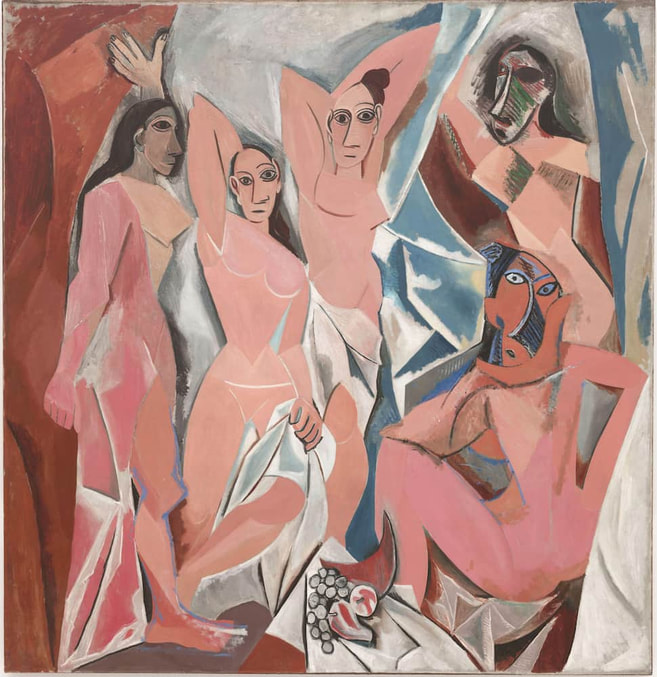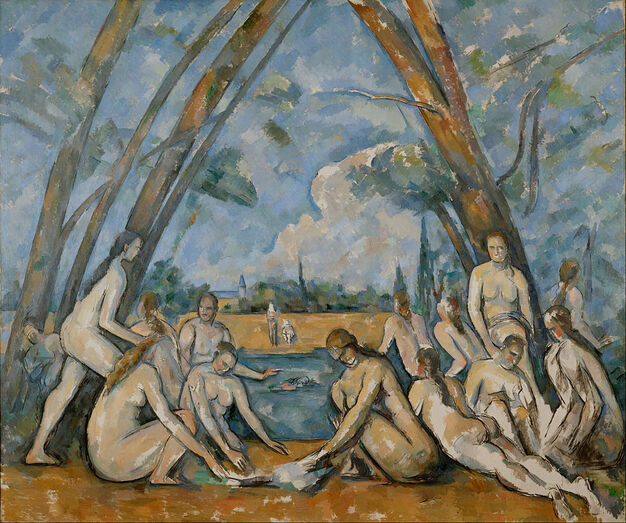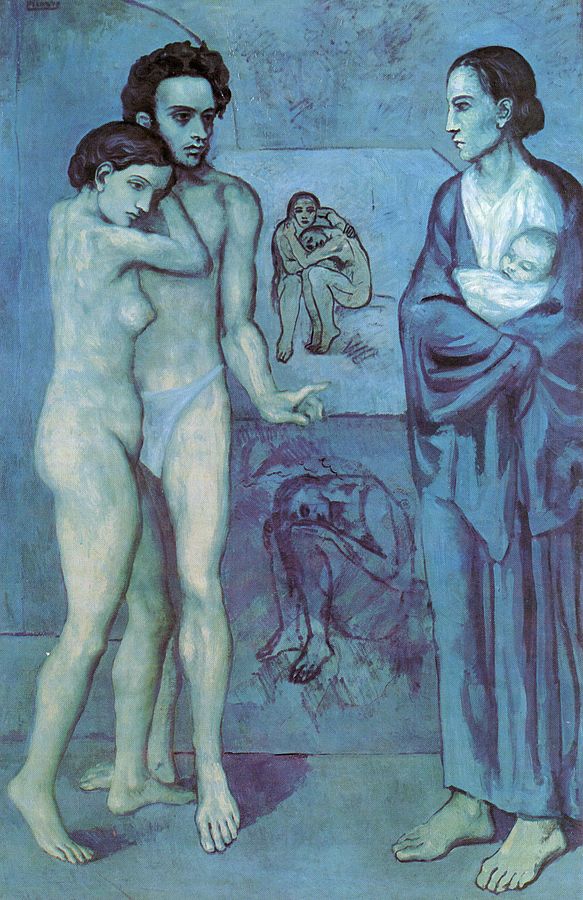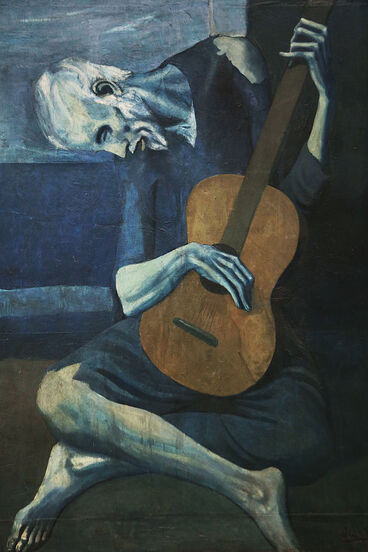|
Where? Floor 5, Gallery 2 of the Museum of Modern Art
When? 1907 What do you see? Five nude women in a brothel. The women are not interacting with each other. The woman on the left holds back a curtain to show the other women. The woman to her right and the woman in the middle are looking boldly at the viewer while exposing their bodies. It is unclear whether they are standing or laying down. Look, for example, at the second woman from the left. Her legs are partly crossed, she has a sheet between her legs and her arm behind her head. The woman in the middle and the two women to her left have relatively normal faces. The two women on the right wear African masks. During the time that Picasso created this painting, he was interested in African artifacts, such as African tribal masks. The woman on the bottom right has her head turned around 180 degrees to look at the viewer, while the standing woman on the right appears from behind a curtain. Picasso uses a lot of angular shapes, like triangles and diamonds, in this painting, to simplify the painting and make it quite abstract. In the foreground is a table in an impossible position to hold the bowl of fruit. In the bowl, we can recognize an apple, a pear, grapes, and a pink slice of melon. Backstory: The French title of this painting is translated as ‘The Young Women of Avignon.’ Avignon refers to a notorious street in the red light district of Barcelona, Spain. Picasso was familiar with this area as he frequented it while skipping school as a teenager and he had also lived nearby it. Picasso, however, disliked the title of this painting which was given by his friend André Salmon for an exposition in 1916 of which the painting was a part of. Picasso preferred the title ‘Mon Bordel’ which means ‘My Brothel’ or ‘Le Bordel d’Avignon’ which means ‘The Brothel of Avignon.’ Fellow artists and friends were initially shocked by this painting as the women in this painting were so ugly. Nowadays, this painting is considered to be one of the most revolutionary paintings of the 20th century, and it is one of the works that marks the beginning of Modern Art. One of the closest, earlier works related to this painting is The Large Bathers by Paul Cézanne in the Philadelphia Museum of Art, created between 1898 and 1905. This is a painting that Picasso had seen shortly before finishing Les Demoiselles d’Avignon. In 1939, the Museum of Modern Art completed a $24,000 transaction to acquire this painting.
What is Cubism? The idea behind cubism is that all forms in nature can be reduced to three solids: cube, sphere, and cone. This reduction was an idea of Paul Cézanne. Basically, the objects in a painting are analyzed, divided into pieces, and then painted in a more abstract form. Thus, realistic details like perspective and color are omitted and replaced by the three solids proposed by Cézanne.
There are different stages of cubism.
Who is Picasso? Pablo Picasso (1881-1973) was born in Malaga, Spain. In his teenage years, he moved to Barcelona, but most of his adult life he lived in France. He was an artistic talent and has created many paintings, sculptures, and poems. Picasso was an innovative artist who developed a large number of art styles. Every few years he drastically changed his art style. For example, between 1901 and 1904, he was in his Blue Period. Two great examples from that period are La Vie which is at the Cleveland Museum of Art and Old Guitarist which is at the Art Institute of Chicago. Between 1904 and 1906 was his Rose Period. In the decade after his Rose Period, he developed various forms of cubism. Together with Georges Braque, Picasso pioneered the Cubist art movement, inspired by artists such as Cézanne, Gauguin, and Toulouse-Lautrec.
Fun fact: Based on sketches by Picasso, we know that he initially planned to include two additional figures in this painting (see one of those sketches here).
0 Comments
|
Categories
All
|
- Home
- Blog
-
Museums
- Alte Pinakothek
- Art Institute of Chicago
- Baltimore Museum of Art
- Barber Institute of Fine Arts
- Bargello
- Barnes Foundation
- British Museum
- Church of Sant’Anastasia
- Cleveland Museum of Art
- Courtauld Institute of Art
- Detroit Institute of Arts
- Frans Hals Museum
- Galleria Borghese
- Gallerie dell'Accademia
- Getty Museum
- Guggenheim
- Hermitage Museum
- Kunsthistorisches Museum
- Kunstmuseum Basel
- Legion of Honor Museum
- Louvre
- Mauritshuis
- Metropolitan Museum of Art
- Musee d’Orsay
- Museum of Fine Arts in Boston
- Museum of Modern Art
- National Gallery in London
- National Gallery of Art
- National Museum in Poznań
- Norton Simon Museum
- Ny Carlsberg Glyptotek
- Palace of Versailles
- Palazzo Pitti
- Palazzo Vecchio
- Petit Palais
- Philadelphia Museum of Art
- Prado
- Pushkin Museum
- Ravenna Art Museum
- Rijksmuseum
- San Diego Museum of Art
- Santa Maria delle Grazie
- St. Peter's Basilica
- Städel Museum
- Statens Museum for Kunst
- Tate Britain
- Tate Modern
- Timken Museum of Art
- Uffizi
- Vatican Museums
- Wallace Collection
-
Artists
- Altdorfer
- Anguissola
- Berlin Painter
- Bosch
- Botticelli
- Boucher
- Bronzino
- Bruegel the Elder
- Brunelleschi
- Cabanel
- Caillebotte
- Canova
- Caravaggio
- Carpeaux
- Cezanne
- Cimabue
- David
- Degas
- Delacroix
- De Maria
- Donatello
- El Greco
- Fontana
- Fra Angelico
- Fragonard
- Gauguin
- Gentileschi
- Gericault
- Gonzalez-Torres
- Goya
- Hals
- Hogarth
- Hokusai
- Ingres
- Leonardo da Vinci
- Lippi, Filippo
- Longhi, Barbara
- Lorrain
- Makovsky
- Manet
- Massys
- Matisse
- Merian
- Michelangelo
- Mochi
- Modigliani
- Monet
- Panini
- Parmigianino
- Perugino
- Picasso
- Pisanello
- Raphael
- Rembrandt
- Renoir
- Reynolds
- Rivera
- Rodin
- Rubens
- Scultori
- Seurat
- Steen
- Tintoretto
- Titian
- Toulouse-Lautrec
- Turner
- Uccello
- Van der Weyden
- Van Dyck
- Van Eyck
- Van Gogh
- Van Hemessen
- Vasari
- Velazquez
- Vermeer
- Veronese
- Vigée Le Brun
-
Locations
- Books
- About Us




